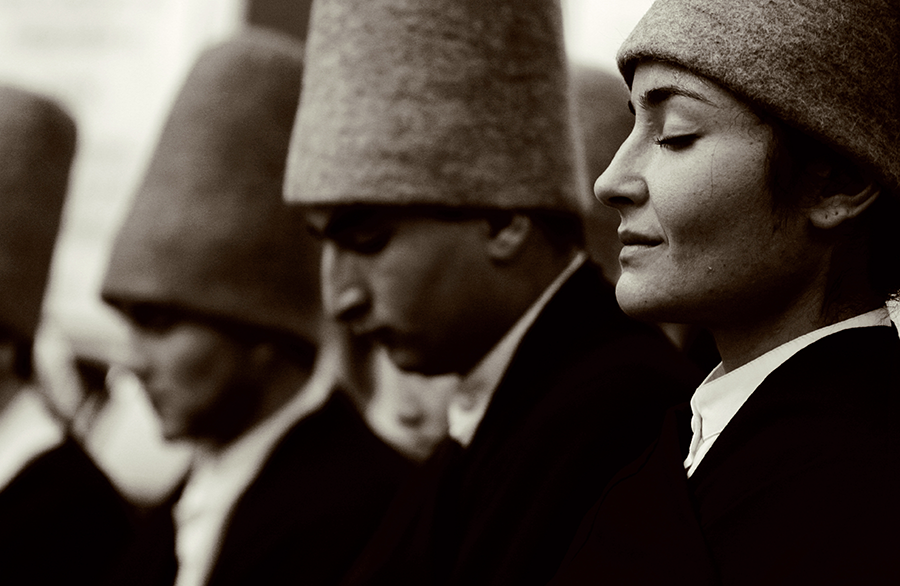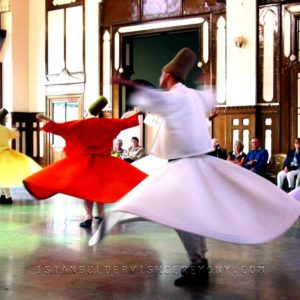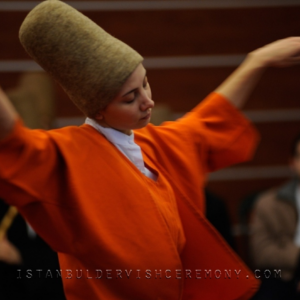Life Story of Mawlana Jalaluddin Rumi
Life Story of Mawlana Jalaluddin Rumi
Mevlana was born in 1207 in Balkh (in present day Afghanistan). Mevlana’s father, Bahaddin Veled, left his homeland to escape the persecution of the Moguls. He first went with his family to Mecca and Medina and then to Asia Minor, seeking protection and asylum. Finally the family arrived in Konya in 1228 at the invitation of the Seljuk Sultan Alaeddin Keykubat. Bahaddin Veled, known as the “chief of all the learned” in Konya, became highly respected among the Seljuks. When he died in 1231, his son Mevlana was 24 years old. After Bahaddin’s death, his followers and students began to gather around Mevlana. They regarded him as the sole intellectual and spiritual heir, and a source of inspiration. In the following years, Mevlana became a teacher in the schools of Konya. As a scholar and theologian, he became even more popular than his father.
In 1244 Mevlana met the dervish Þems-i Tebriz, or Shemseddin of Tabriz. This meeting marked the beginning of a great mystic love between the two men. The influence of Shemseddin changed the once sober-minded theologian, Mevlana, into an ecstatic mystic. He neglected his work in order to have meditative sessions with Shemseddin, which often lasted weeks.
Mevlana’s family and also his students and disciples disapproved of this relationship. Shemseddin finally had to flee from Konya. Mevlana suffered greatly and tried all ways to locate him. In the end Mevlana’s sons brought Shemseddin back to Konya. However after his return, the attitude of Mevlana’s family and of his disciples toward Shemseddin did not change. Around 1247 he disappeared again and was never found. Speculations indicate, that he might even have been murdered.
After Shemseddin disappeared, Mevlana chose Selahaddin Zerkubi as his spiritual confidant until he died 10 years later. Mevlana dictated his major work. This six-volume work, known as the “Mesnevi” consists of 26,000 verses. It begins with the words, “Listen to the reed flute — talking about separation..”. The reed flute (ney) plays a special role in the ritual of the Mevlevi order. The Mesnevi, a masterpiece of Islamic mystic literature was written in verse, and included philosophical, mystical and spiritual messages. On December 17, 1273, Mevlana Celaleddin-i Rumi died in Konya.
The ritual dance of his followers, more commonly known as the Whirling Dervishes, symbolizes a release from earthly ties, which liberates the soul and prepares it for union with the divine.
The dance consists of three parts, which represent the stages of reaching, seeing, and uniting with God. In the first stage, the dancers whirl three times accompanied by the mournful sound of the ney. During the second part, they remove their coats. This symbolizes the release of the soul from earthly concerns. Then they slowly begin to whirl with their right hands palms up and left hands palms down. This gesture indicates: “What we receive from God we give to man, while we have nothing ourselves”.
Their whirling movement represents the earth revolving on its axis and their rotation around the hall symbolizes the earth orbiting the sun. In the final part of the dance, the sheik enters, the rhythm becomes more rapid and the dancers are more frenzied. Then the flute signals the moment of man’s union with God.
Actually Mevlana did not found the Mevlana order. It was established in his name after his death by his son Sultan Veled, himself an important poet. The Mevlevi sect has lost its former importance. Only in December Konya becomes the center of the Mevlana celebrations.
Rūmī, in full Jalāl al-Dīn Rūmī, also called by the honorific Mawlānā, (born c. September 30, 1207, Balkh [now in Afghanistan]—died December 17, 1273, Konya [now in Turkey]), the greatest Sufi mystic and poet in the Persian language, famous for his lyrics and for his didactic epic Mas̄navī-yi Maʿnavī (“Spiritual Couplets”), which widely influenced mystical thought and literature throughout the Muslim world. After his death, his disciples were organized as the Mawlawiyyah order.
Rūmī’s use of Persian and Arabic in his poetry, in addition to some Turkish and less Greek, has resulted in his being claimed variously for Turkish literature and Persian literature, a reflection of the strength of his influence in Iran and Turkey. The influence of his writings in the Indian subcontinent is also substantial. By the end of the 20th century, his popularity had become a global phenomenon, with his poetry achieving a wide circulation in western Europe and the United States.
Early Life And Travels
Jalāl al-Dīn’s father, Bahāʾ al-Dīn Walad, was a noted mystical theologian, author, and teacher. Because of either a dispute with the ruler or the threat of the approaching Mongols, Bahāʾ al-Dīn and his family left their native town of Balkh about 1218. According to a legend, in Nīshāpūr, Iran, the family met Farīd al-Dīn ʿAṭṭār, a Persian mystical poet, who blessed young Jalāl al-Dīn. After a pilgrimage to Mecca and journeys through the Middle East, Bahāʾ al-Dīn and his family reached Anatolia (Rūm, hence the surname Rūmī), a region that enjoyed peace and prosperity under the rule of the Turkish Seljuq dynasty. After a short stay at Laranda (Karaman), where Jalāl al-Dīn’s mother died and his first son was born, they were called to the capital, Konya, in 1228. Here, Bahāʾ al-Dīn Walad taught at one of the numerous madrasahs (religious schools); after his death in 1231 he was succeeded in this capacity by his son.
A year later, Burhān al-Dīn Muḥaqqiq, one of Bahāʾ al-Dīn’s former disciples, arrived in Konya and acquainted Jalāl al-Dīn more deeply with some mystical theories that had developed in Iran. Burhān al-Dīn, who contributed considerably to Jalāl al-Dīn’s spiritual formation, left Konya about 1240. Jalāl al-Dīn is said to have undertaken one or two journeys to Syria (unless his contacts with Syrian Sufi circles were already established before his family reached Anatolia); there he may have met Ibn al-ʿArabī, the leading Islamic theosophist whose interpreter and stepson, Ṣadr al-Dīn al-Qunawī, was Jalāl al-Dīn’s colleague and friend in Konya.
The Influence Of Shams Al-Dīn
The decisive moment in Rūmī’s life occurred on November 30, 1244, when in the streets of Konya he met the wandering dervish—holy man—Shams al-Dīn (Sun of Religion) of Tabrīz, whom he may have first encountered in Syria. Shams al-Dīn cannot be connected with any of the traditional mystical fraternities; his overwhelming personality, however, revealed to Jalāl al-Dīn the mysteries of divine majesty and beauty. For months the two mystics lived closely together, and Rūmī neglected his disciples and family so that his scandalized entourage forced Shams to leave the town in February 1246. Jalāl al-Dīn was heartbroken, and his eldest son, Sulṭān Walad, eventually brought Shams back from Syria. The family, however, could not tolerate the close relation of Jalāl al-Dīn with his beloved, and one night in 1247 Shams disappeared forever. In the 20th century it was established that Shams was indeed murdered, not without the knowledge of Rūmī’s sons, who hurriedly buried him close to a well that is still extant in Konya.
This experience of love, longing, and loss turned Rūmī into a poet. His poems—ghazals (about 30,000 verses) and a large number of robāʿīyāt (“quatrains”)—reflect the different stages of his love, until, as his son writes, “he found Shams in himself, radiant like the moon.” The complete identification of lover and beloved is expressed by his inserting the name of Shams instead of his own pen name at the end of most of his lyrical poems. The Dīvān-e Shams (“The Collected Poetry of Shams”) is a true translation of his experiences into poetry; its language, however, never becomes lost in lofty spiritual heights or nebulous speculation. The fresh language, propelled by its strong rhythms, sometimes assumes forms close to popular verses. There would seem to be cause for the belief, expressed by chroniclers, that much of this poetry was composed in a state of ecstasy, induced by the music of the flute or the drum, the hammering of the goldsmiths, or the sound of the water mill in Meram, where Rūmī used to go with his disciples to enjoy nature. He found in nature the reflection of the radiant beauty of the Sun of Religion and felt flowers and birds partaking in his love. He often accompanied his verses by a whirling dance, and many of his poems were composed to be sung in Sufi musical gatherings.
A few years after Shams al-Dīn’s death, Rūmī experienced a similar rapture in his acquaintance with an illiterate goldsmith, Ṣālāḥ al-Dīn Zarkūb. It is said that one day, hearing the sound of a hammer in front of Ṣalāḥ al-Dīn’s shop in the bazaar of Konya, Rūmī began his dance. The shop owner had long been one of Rūmī’s closest and most loyal disciples, and his daughter became the wife of Rūmī’s eldest son. This love again inspired Rūmī to write poetry.
After Ṣālāḥ al-Dīn’s death, Ḥusām al-Dīn Chelebi became his spiritual love and deputy. Rūmī’s main work, the Mas̄navī-yi Maʿnavī, was composed under his influence. Ḥusām al-Dīn had asked him to follow the model of the poets ʿAṭṭār and Sanāʾi, who had laid down mystical teachings in long poems, interspersed with anecdotes, fables, stories, proverbs, and allegories. Their works were widely read by the mystics and by Rūmī’s disciples. Rūmī followed Ḥusām al-Dīn’s advice and composed nearly 26,000 couplets of the Mas̄navī during the following years. It is said that he would recite his verses even in the bath or on the roads, accompanied by Ḥusām al-Dīn, who wrote them down. The Mas̄navī, which shows all the different aspects of Sufism in the 13th century, often carries the reader away with loose associations of thought, so that one understands what subjects the master had in mind at a particular stage of his life. The work reflects the experience of divine love; both Ṣalāḥ al-Dīn and Ḥusām al-Dīn were, for Rūmī, renewed manifestations of Shams al-Dīn, the all-embracing light. He called Ḥusām al-Dīn, therefore, Ḍiyāʾ al-Ḥaqq (“Light of the Truth”); ḍiyāʾ is the Arabic term for sunlight.
Rūmī


